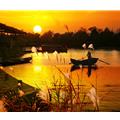媒体:原创 作者:刘想 摘录
专业号:西溪湿地
2008/7/7 16:34:16
中国杭州西溪第二届湿地论坛论文摘要选编17
articipation of the Local Stakeholders in
East Kolkata Experience
Nitai Kundu, Saila Ghosh, Mousumi Pal, Baishali Bagchi
Institute of Environmental Studies and Wetland Management
East Kolkata Wetlands (EKW) is widely acclaimed by urban planners and ecologists for its unique role in urban waste recycling through a natural process developed by the local people. The gradual eastward slope of the wetland area, surrounding the city of Kolkata on the eastern side, creates a natural drainage system for the city.
Initially the eastern side of the city, i.e. the salt-water lake, provided a natural stock for fishes. The local people were not the legal owners of the area. They were only dependent on the catch in this salt water, which was actually a spill area of the river Bidyadhari. Since, the increasing flow of sewage in the lake affected the amount of catches in this spill area of the river, the traditional practice of fish harvesting came to be threatened. But, the fishermen, in the face of a threatened livelihood, and taking the advantage of newly built underground sewer system in Kolkata with its disposal in Salt Lake area, developed a unique system, by which, the sewage is first stored in shallow tanks and then allowed to decompose under the sun, creating photosynthetic algae, which in turn provide very nutritious fish food. Thus, the sewage is recycled, and the clean water is discharged in the river Bidyadhari.
The system provides a total and comprehensive system of waste management. In recognition of its unique character, EKW has been declared as a Ramsar Site (August 19, 2002) by the ‘Ramsar Convention Bureau.’ It recognizes the EKW as world-renowned model “of a multiple use wetland.” The site’s natural resource recovery systems, developed by the local people, have saved the city of Kolkata from the costs of constructing and maintaining wastewater treatment plants. Considering the importance of the wetland Communication, Education and Public Awareness (CEPA), the newly set up ‘East Kolkata Wetland Management Authority’ has decide to set up a ‘Nature and Wetland Interpretation Centre,’ along with a Wetland Park for dissemination of the lessons of EKW Ecosystem, by involving local stakeholders.
This paper tries to provide a detailed idea regarding the development and management of the said project, which aims at raising public awareness regarding the necessity as well as the advantages of EKW. The authority hopes that this project of the Wetland Park will work out as an example of conservation of the wetlands along with its habitats in India.
Key words: East Kolkata Wetlands; natural resource recovery system
社区群众对湿地公园计划和管理的参与:东科卡塔经验
Nitai Kundu, Saila Ghosh, Mousumi Pal, Baishali Bagchi
印度湿地管理和环境研究中心
东科卡塔湿地(EKW),由于它在通过地方群众开发的一个自然过程来处理城市废物方面所起的独特作用而得到城市设计家和生态学家的广泛支持。该湿地区内逐渐朝东的斜坡,围绕在科卡塔城市的西边,创造了一个自然的排水系统。
起初,城市的东边,如盐水湖,是一个自然的鱼类资源库,但地方群众并没有合法的利用,他们仅仅靠在此地盐水中打捞而生。这里实际上是彼得亚得哈里河的一个泻洪区。随着湖中污水排放量的增加,严重影响了这一区域的捕获量,传统的渔业受到了威胁。然而在威胁面前,渔民利用新建的地下排水系统和拥有盐水湖的优势,发展了一个独特的系统,通过该系统污水首先被储存在浅槽里,然后在太阳光下被分解,生成光合作用的藻类,提供营养非常丰富的鱼类食物。这样一来,废水得到了再循环,净水被排放到比德亚得哈里河。这一系统提供了一个完整的废水管理的综合系统。鉴于对其独特性的认可,东科卡塔湿地已经被拉姆萨尔公约局于2002年8月19日宣布为国际重要湿地,确定东科卡塔湿地为世界多用途湿地的典范。此地由地方群众开发的自然资源恢复系统把科卡塔市从建设和维护废水处理装置的大量花费中解救了出来。
考虑到湿地交流、教育和公众意识的重要性(CEPA),为了让地方群众参与传播东科卡塔湿地的生态系统经验和教训,新成立的东科卡塔湿地管理权利机构已经决定建立自然和湿地宣教中心及湿地公园。
本文试图阐述上述项目发展和管理的详细思路,其目的在于提高关于东科卡塔湿地重要性和必要性的公众意识。主管部门希望湿地公园的这个项目能够成为印度相同生境湿地保护的范例。
关键词:东科卡塔湿地 自然资源恢复系统
阅读
290
推荐
| 我也说两句 |
| 版权声明: 1.依据《服务条款》,本网页发布的原创作品,版权归发布者(即注册用户)所有;本网页发布的转载作品,由发布者按照互联网精神进行分享,遵守相关法律法规,无商业获利行为,无版权纠纷。 2.本网页是第三方信息存储空间,阿酷公司是网络服务提供者,服务对象为注册用户。该项服务免费,阿酷公司不向注册用户收取任何费用。 名称:阿酷(北京)科技发展有限公司 联系人:李女士,QQ468780427 网络地址:www.arkoo.com 3.本网页参与各方的所有行为,完全遵守《信息网络传播权保护条例》。如有侵权行为,请权利人通知阿酷公司,阿酷公司将根据本条例第二十二条规定删除侵权作品。 |
 m.quanpro.cn
m.quanpro.cn